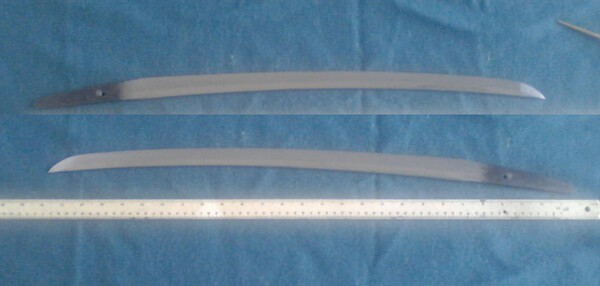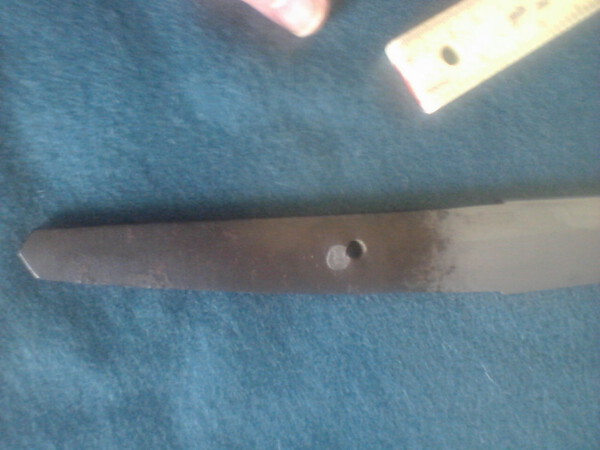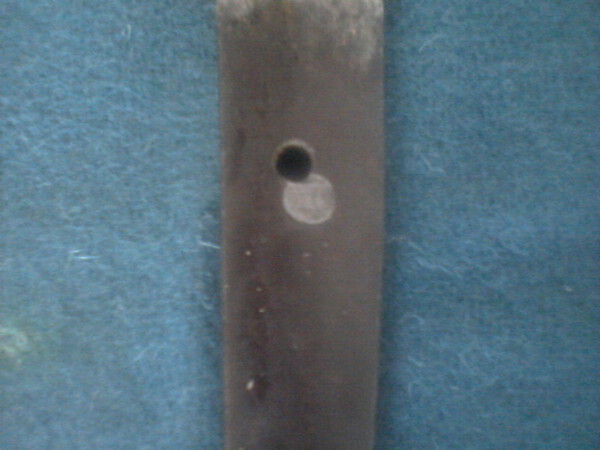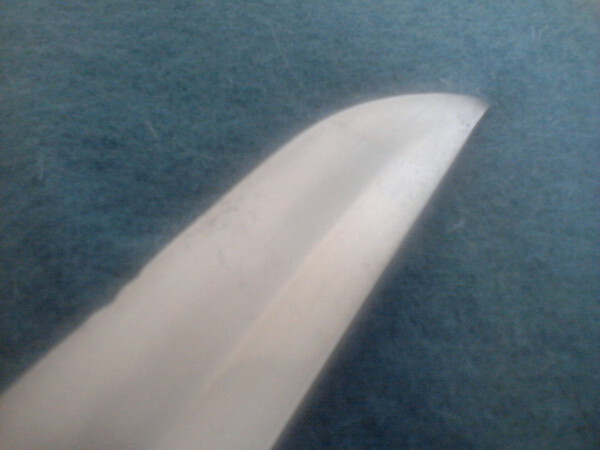-
Posts
1,690 -
Joined
-
Last visited
-
Days Won
11
Everything posted by Dave R
-
This is a quote from an excellent article by C.U. Guido Schiller and S. Alexander Takeuchi, Ph.D. University of North Alabama. http://www.arscives.com/historysteel/ja ... rticle.htm "The executive order issued on July 18, Shôhô 正保 2 (1645 AD) only prohibited the commoners wearing swords over 1.8 Shaku 尺 (54.54 cm). This enabled non-Samurai travelers on the Tôkaidô 東海道 road to arm themselves with a short sword against robbers that were encountered quite frequently in unpopulated areas, and also enabled the chief of police to arm the Komono 小者, non-Samurai 侍 police assistants in some extreme events" So according to this anything over 54.54 will most likely be a Samurai's second sword and so should really have a rounded end to the saya. Having said that I have no doubt there are exceptions, and these will hopefully be posted on this thread.
-
Stephen, the style of saya is a good clue flat end Merchants Wakizashi, rounded end Samurai Wakizashi.
-
You can also add Hira Zukuri, without yokote or shinogi. To the best of my knowledge the Law was more about length of blade, rather than style. A merchants Wakizashi has a flat/square ended saya and I have two of those, one standard Shinogi Zukuri and the other Hira Zukuri. I also have a Samurai Wakizashi, rounded end to the Saya and longer, with a Shinogi Zukuri blade. I would guess date of manufacture and the taste of the buyer or the sword school he followed probably had more to do with it. Dave
-
I buy from him every now and then, and generaly have been happy with what I got! Check the description, Edo, Old and Little Old which he defines quite clearly. Pay by Paypal and if you have a problem, "not as described", use their "reconciliation" service..... no one selling on Ebay wants to get a ban, and Ebay and Paypal do ban persistent offenders. I got a dodgy Tsuba off a different vendor, and a mere mention of using Ebay's complaint system got my money back and a message to not bother returning the Tsuba. Check the picture, I bought a tsuba off him, described as iron but clearly copper in the pictures and yes when it arrived it was copper..... English is not his first language! For small items ask if he can send it "Small Parcel-SAL", not tracked or insured but averages $12 rather than $30! Always remember he is a Dealer making a living by selling this stuff, not a collector and not an altruist.
-
Many thanks for these answers, this makes things a lot clearer.....
-
I am aware that ideally a sword has all it's mounts in much the same metal, as in copper alloy mounts throughout or all iron throughout. I am interested to know if "back in the day" swords were mounted with copper alloy fuchi-kashira etc and iron tsuba, or if this was-is a definate no-no. Dave
-

LETS BE CAREFUL with the use of Japanese nomenclature
Dave R replied to watsonmil's topic in Tanegashima / Teppo / Hinawajū
What a relief! In my opinion there is no doubt that some things related to Nihonto demand the use of Japanese terms,.... and some do not! But then, I am an iconoclast, and believe that the important thing is a love of, interest in, and desire to know more about Japanese blades and the broader culture. I also collect Wafuku and other antiquities associated with Edo society, and every so often have to explain common terms to Nihonto collectors..... and strangely enough they are not embarrassed by their lack of familiarity with these terms. -
Having read all the above and chased up a couple of links, I now wonder if one of mine is one of these beasts. Sorry for the quality (lack of ) of the photo's.... quick and dirty, done while reading this thread.
-
The reason I have the link is that I am looking to do this same Tsuka-maki on one of my own. A probably Koto Wakizashi that may have been cut down from a Tachi.
-
A fair bit of useful information here, sorry if this is already posted on site. http://www.thejapanesesword.com/forum/v ... f=29&t=124
-
This looks very much like a sword in shirasaya, a mount specifically for storage not wear, which has been modified for field use. Leather field cover, improvised copper alloy hanger, and an aluminium throat mount. Is there a similar leather cover for the hilt anywhere? I suggest that you would get the best price for this selling it as "Militaria" rather than "Nihonto".
-
What struck me about this was that it was in a Shirasaya, and what looked to be quite a good one, with a leather field cover sewn over it. Was this a "Last Ditch" sword? Dave R
-
I think the above picture is from GC Stone's "Glossary" where he describes them as being used by Yamabushi monks.
-

koa isshin with the South Manchurian Railway Company logo
Dave R replied to Gilles's topic in Military Swords of Japan
Nice. -
Believe it or not, despite being a member here since 2012 I had not noticed this thread before..... So here goes. My name is Dave Rushworth, and I have been collecting Oriental Arms and Armour continuously since 1967. I bought my first Japanese blade, a very trashed Wakizashi for £4.10s, and considering the abuse I gave it out of ignorance I am glad I don't have it around anymore to embarrass me. I have during the last 3 years started collecting Japanese antiques again after a hiatus of a couple of decades and am working on getting back up to speed ... there have been quite a few changes in the scene and a vast increase in the knowledge available. I find this site to be an invaluable resource, and long may it continue to be so. Living in Leeds I have easy access to the Royal Armoury, which I take regular advantage of, and am a member of the Northern To-Ken Society UK.
-
I have also been told that a Lead (as in the metal) wire can be used to gauge the inside of the Saya and Tsuka.
-
http://www.namikawa-ltd.co.jp/cgi/item_ ... te=15&no=9
-
Which is why I posted a link to the article, rather than just making a statement.
-
Something to bear in mind is that the longer Wakizashi are Samurai swords, my understanding of the following article is that Merchants were restricted to the shorter length Ko-Wakizashi. http://archive.is/xZVmU
-
It frustrates me that I do not have access to all my files at present. I have seen this style of Tsukamaki before, and there is a specific name for it. Not common, but not unique either, or particularly cheap. I saw a similar Koshirae for sale last year on *bay, either by "Mugendo" or "Diamyou".
-
I briefly owned the Police version of one of these, Bakelite grip and nickel scabbard etc, with a very worn, signed, Shinto, Wakizashi blade...... Horribly flawed, so I regretfully let it go.
-
This is going to seem an odd request...perhaps. I am looking for information on when Katana Makura (sword cushions) first appeared? So far the earliest actual example I have found was dated to the Meiji period, but I wonder if they existed before that. I imagine that they were fairly ephemeral being no more than small cushions, and probably discarded when soiled, so I am hoping for evidence in the form of illustrations in contemporary prints, or mentions in literature. Information on how they were made, now and in the past is also very welcome. The Meiji period one I saw for sale was described as made from reused kimono silk and stuffed with sawdust. Dave
-
You took the words right out of my mouth..... Dave R






